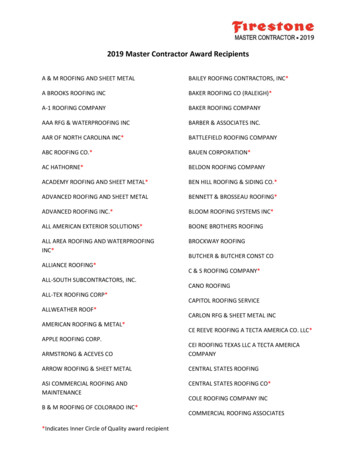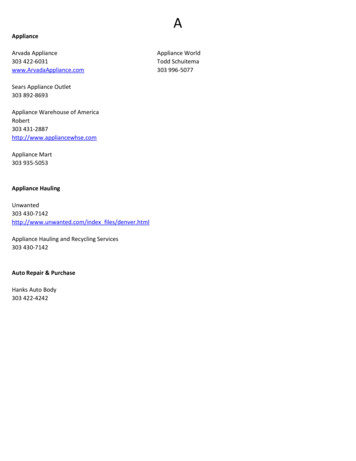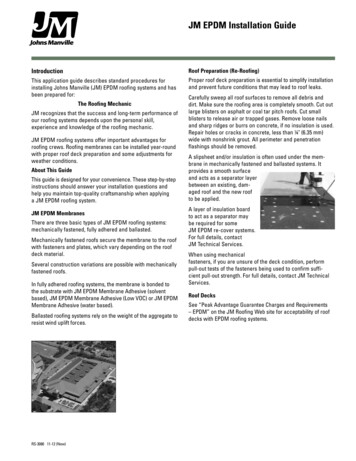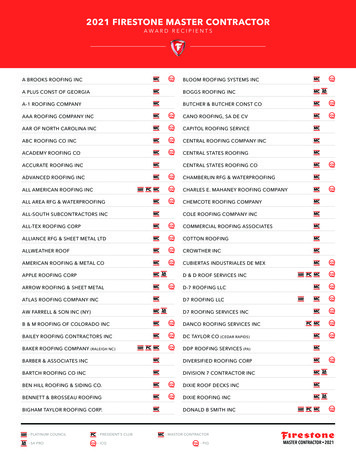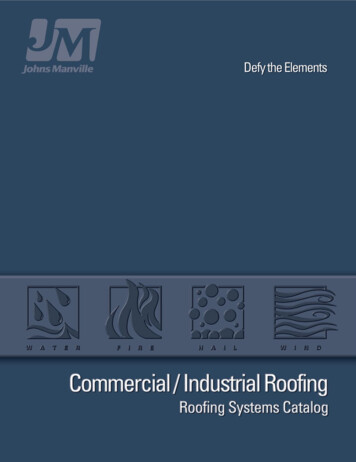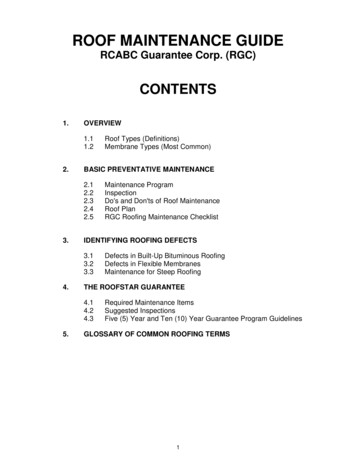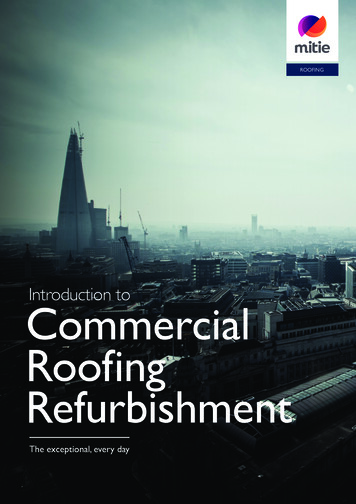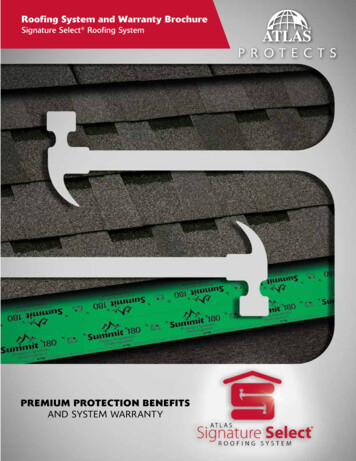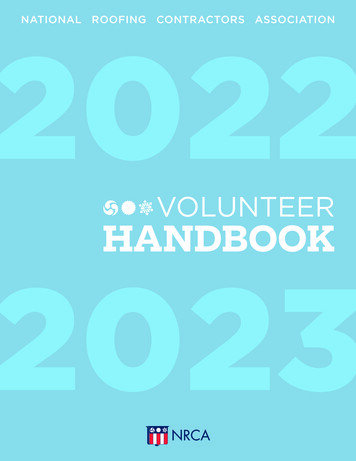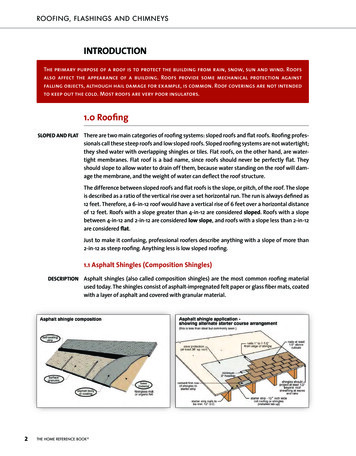
Transcription
ROOFING, FL ASHINGS AND CHIMNEYSINTRODUCTIONThe primary purpose of a roof is to protect the building from rain, snow, sun and wind. Roofsalso affect the appearance of a building. Roofs provide some mechanical protection againstfalling objects, although hail damage for example, is common. Roof coverings are not intendedto keep out the cold. Most roofs are very poor insulators.1.0 RoofingSLOPED AND FLAT There are two main categories of roofing systems: sloped roofs and flat roofs. Roofing profes-sionals call these steep roofs and low sloped roofs. Sloped roofing systems are not watertight;they shed water with overlapping shingles or tiles. Flat roofs, on the other hand, are watertight membranes. Flat roof is a bad name, since roofs should never be perfectly flat. Theyshould slope to allow water to drain off them, because water standing on the roof will damage the membrane, and the weight of water can deflect the roof structure.The difference between sloped roofs and flat roofs is the slope, or pitch, of the roof. The slopeis described as a ratio of the vertical rise over a set horizontal run. The run is always defined as12 feet. Therefore, a 6-in-12 roof would have a vertical rise of 6 feet over a horizontal distanceof 12 feet. Roofs with a slope greater than 4-in-12 are considered sloped. Roofs with a slopebetween 4-in-12 and 2-in-12 are considered low slope, and roofs with a slope less than 2-in-12are considered flat.Just to make it confusing, professional roofers describe anything with a slope of more than2-in-12 as steep roofing. Anything less is low sloped roofing.1.1 Asphalt Shingles (Composition Shingles)DESCRIPTION2 sphalt shingles (also called composition shingles) are the most common roofing materialAused today. The shingles consist of asphalt-impregnated felt paper or glass fiber mats, coatedwith a layer of asphalt and covered with granular material.THE HOME REFERENCE BOOK
ROOFING, FL ASHINGS AND CHIMNEYS sphalt shingles were historically classified by weight. Today, asphalt shingles are classifiedAby the manufacturer’s warranty. They are known as 15-year, 20-year, 25-year, 30-year or35-year shingles. Modern shingles are available in various textures and patterns. While shingleswith longer warranties will generally last longer than shingles with shorter warranties, thewarranty period should not be considered a guarantee of service life.WEAR FACTORS egardless of the type of shingle used, there are two significant factors with regard to wearR– exposure and slope. Sunlight is one of the biggest enemies of asphalt roofs and in manyareas, the south and west exposures wear out the fastest. The steeper the slope, the longerthe shingles will last.ROOFING/FLASHINGS/CHIMNEYSLIFE EXPECTANCYAs asphalt shingles wear, they lose their granular covering. The granular material protects theshingles from ultra-violet light. As granules wear off, the shingles dry out and become brittle.They crack, buckle, and curl. Shingles wear out first where the granular material is lost. Thismay be due to heavy foot traffic, abrasion from tree branches, erosion from downspoutsdischarging onto the roof surface, or manufacturing defects.SELF-SEALING Most asphalt shingles have self-sealing strips, a strip of asphalt running across the middle ofSHINGLES the shingle. The shingle above overlaps the lower shingle, with the bottom edge covering thisstrip. When the sun warms the roof surface, the two shingles stick together. This protects theshingles from being blown off ina heavy wind. Shingles installedin cold weather do not seal themselves until the weather warmsup. They are vulnerable to winddamage during this period.Conventional asphalt shinglesROOF SLOPES can be used on a slope as lowas 4-in-12. Shingles can also beused down to a slope of 2-in-12if the roof is first covered withnon-perforated, asphalt-saturated felt papers or a waterproofmembrane. The felt papers areoverlapped by 50% and thesection at the eaves (from thebottom edge up to 24 inchesbeyond the exterior wall) iscemented in place to provideextra protection. After construction, you can’t tell whetherthis was done, especially sincethe shingles themselves may becemented down.SHINGLES ANDIn the past, special shingleswere made for this application.These are no longer used.THE HOME REFERENCE BOOK 3
ROOFING, FL ASHINGS AND CHIMNEYSRE-ROOFING hile it is better to remove old roofing before re-roofing, a second layer of shingles can beWinstalled over one layer of shingles if the layer being covered is relatively smooth and flat.Longer nails must be used. If there are already two layers of shingles on the roof, all shinglesshould be removed before re-roofing.Asphalt shingles are occasionally installed over a single layer of wood shingles or slateshingles; however, the new shingles will perform better and last longer if the old roofingmaterials are removed.1.2 Wood Shingles and ShakesDESCRIPTION ood shingles are machine cut. They are typically smaller, thinner and more uniform than woodWshakes. Traditionally, wood shakes were hand split or mechanically split, although machinesawn shakes are also available. Wood shakes are thicker and split shakes have a much moreuneven surface. Most wood shingles are cedar; however, redwood and pine are also used.Wood shingles can be used on roofs with a slope aslow as 3-in-12; however, 6-in-12 or more is recommended. Wood shingles vary in length between16 inches and 24 inches. On a good quality installation, no more than one-third of each shingle isexposed to the weather.Shakes may be up to 24 inches long, with no morethan half of the shingle exposed. Shakes typicallyhave heavy building paper interwoven with theshakes to prevent wind driven rain and snowgetting into the roof between the shakes.4THE HOME REFERENCE BOOK
ROOFING, FL ASHINGS AND CHIMNEYSLIFE EXPECTANCY The life expectancy of good quality wood shingles is generally 30 to 40 years; however,Too much shade and moisture allows moss to grow. This can lead to rot. Wood shingles andshakes may suffer mechanical damage from tree branches, foot traffic, snow shovelling, etc.Another factor affecting the life of wood shingles is their ability to dry quickly. Wood roofingover spaced sheathing boards has lots of air movement on the back of the shingles or shakes,promoting uniform drying. This helps extend the life of the roof. Wood roofing applied overplywood sheathing does not dry as quickly or uniformly. Some experts say the use of plywoodwill halve the life of wood shingles.ROOF TUNE-UPROOFING/FLASHINGS/CHIMNEYSlow quality shingles deteriorate badly in 15 to 20 years. The rate of wear depends largely onexposure (the amount of shingle which is exposed to the weather), the slope (the steeperthe better), the grade of shingle (there are four), and the amount of sun and shade they see.Sunlight dehydrates the shingles, resulting in splitting and cupping of the shingles. Someshingles ‘burn through’, with holes developing as a result of exposure to the sun. he shakes or shingles may deteriorate at different rates. The roof’s life can be extendedTby several years by carrying out a roof tune-up. This typically involves spot replacement ofdamaged shakes or shingles (often located on the hip and ridge caps) as well as the additionof metal shims under any split shakes or shingles where the split is located directly over anadjacent keyway (the vertical joint between individual shakes or shingles). The tune-upshould also include a roof cleaning if there is moss and/or algae growth.It is important to keep wood roofing clear of organic debris, moss and algae buildup to extendits life. High pressure washing is not recommended as it may damage the roofing. Lowpressure washing may successfully remove loose material without damaging the roof. Theroofing can then be sprayed with a combination moss killer and non-toxic detergent to kill anymoss, algae or fungus. A heavy rain will usually remove the dead moss.The majority of wood roofing is western red cedar which contains natural oils that resistdecay. There are various treatments available that claim to increase this natural decayresistance. These claims and their cost should be carefully evaluated.RE-ROOFING Wood shingles or shakes can be installed over a single layer of asphalt shingles; however, it isbetter to remove existing shingles to allow the wood roof system to breathe. Wood roofingshould never be installed over an old wood roof.1.3 Slate ShinglesDESCRIPTION late is a natural sedimentary rock that is quarried; the quality can vary. High quality slateSroofs can last 200 years. Low-quality roofs may fail in less than 20 years. Slate roofs are heavy,weighing three to five times as much as conventional asphalt shingles. A slope of six-in-twelveor more is recommended and, slates are usually installed with less than 50% of each slateexposed to the weather. The slate above covers more than half of the slate below.THE HOME REFERENCE BOOK 5
ROOFING, FL ASHINGS AND CHIMNEYSWEAR FACTORS hile some slates are of low quality and tend to flake and shale, the biggest problem withWslate roofs is often the nails holding the slates in place. With time, the nails rust and allow theslates to slide out of position. Copper and stainless steel nails last longer than galvanizednails. Once one slate has come loose, water rusts the nails holding nearby slates in place. Goodmaintenance is important on an older slate roof. While it is not common practice, slate roofsshould be inspected and repaired at least annually. Slates that have slipped are re-secured,and slates that have cracked or split as a result of mechanical damage are replaced. As ageneral rule, roof replacement makes sense when more than 10% is in need of repair.FLASHINGS The flashing materials do not last as long as the slates themselves. Metal flashings are usedwherever the roof changes direction or meets an obstruction such as a chimney. When theflashings rust, a section of the roof may have to be removed to install a new flashing. Thisis an expensive proposition. Copper and lead flashings are expensive, but last longer thangalvanized steel or aluminum flashings.REPAIR WORK Another difficulty with slate roofs is finding qualified people to repair them. Since slate hasnot been used commonly for the past 50 years, their installation and repair is a vanishing art.Many slate roofs that can be saved are replaced with modern roofing materials, more familiarto the modern roofer.RE-ROOFING Slate roofs should never be installed over another layer of roofing. New slate roofs on homesare rare because they are so expensive. Installing slate on a building not designed for slateoften requires structural modifications to the roof to carry the weight of the slates.6THE HOME REFERENCE BOOK
ROOFING, FL ASHINGS AND CHIMNEYSROOFING/FLASHINGS/CHIMNEYS1.4 Concrete and Clay TilesDESCRIPTION These are high quality roofingsystems with life expectanciesof 50 to 100 years. Like slate,these roofs are heavy, weighing four to five times as muchas asphalt shingles. Modifications to the roof structure maybe required if replacing asphaltshingles with concrete.Concrete and clay tiles can beused on a slope as low as 4-in-12but as with most roofing systems, steeper is better. Manycurrent standards recommend6-in-12 as a minimum. Theamount of overlap (exposure ofthe tiles) varies depending onthe roof system. Systems witha limited overlap are prone toleakage during wind-drivenrains. Many loose-fitting concrete and clay tile roofs havea watertight membrane suchas built-up roofing below, toact as a backup. The tiles provide protection against fire,ultraviolet light and mechanicaldamage.THE HOME REFERENCE BOOK 7
ROOFING, FL ASHINGS AND CHIMNEYSFASTENING ome systems are nailed in place while others use special clips or wire ties. In some regions,Sthe tiles are mortared into place. In areas prone to high winds and hurricanes, these heavytiles can be torn off roofs, becoming dangerous projectiles.WEAR FACTORSL ike any brittle roofing system, concrete and clay tiles are subject to mechanical damage, andlike any long-lasting roof system, the fasteners may wear out before the tiles. Dependingupon the design of the roof system, they can be very difficult to repair.Concrete and clay tiles that are not flat are more difficult to flash.RE-ROOFING Concrete or clay tiles cannot be installed over another roofing system, with the exceptionof a single layer of asphalt shingles or over a built-up roof. The roof structure may requiremodification to handle the additional load.8THE HOME REFERENCE BOOK
ROOFING, FL ASHINGS AND CHIMNEYSDESCRIPTIONLIFE EXPECTANCYROOFING/FLASHINGS/CHIMNEYS1.5 Fiber Cement ShinglesF iber cement shingles consist ofa mixture of Portland cement,water and fibers. Traditionally,asbestos fibers were used, butsince the 1970s asbestos hasbeen replaced by fiberglass or,more commonly, wood fibers.The type of fiber used in shingles is not determined during ahome inspection. hese shingles traditionally had aTlife expectancy of 30 to 50 years,although some newer shinglescarry warranties as long as 60 years. Some fiber cement shingles are made to look like wood shingles.Fiber cement shingles are brittle and are susceptible to mechanical damage. Older shinglesoften discolor and promote the growth of fungus or moss. They are difficult to repair andreplacement shingles may be hard to obtain.RE-ROOFING New fiber cement shingles are rarely installed. Ideally, existing asbestos cement shinglesshould be removed prior to re-roofing. Because of the asbestos content of old shingles, specialprovisions should be made for handling and disposing of the material.1.6 Metal RoofingDESCRIPTION There are many types of metal roofs. Copper, galvanized steel, pre-painted or coated steel,terne and tin are common. Some metal roofs have a granular surface embedded in the finish.Most metal roofs (particularly copper) are expensive systems, but they last longer thanasphalt shingles. They can be installed as sheets or shingles. Sheets and shingles can be usedon sloped roofs; however, flat roofs are only covered in sheets. Sheet metal roofs can havedifferent types of seams including soldered and crimped.THE HOME REFERENCE BOOK 9
ROOFING, FL ASHINGS AND CHIMNEYSWEAR FACTORS Like any roofing system there are disadvantages; seams may split or be damaged. All metalroofs except copper and pre-painted or pre-coated roofs should be painted on a regular basis.Metal roofs should never be covered with tar because moisture trapped below the tar causesrusting. Tar covered metal roofs are usually near the end of their life. Metal roofs are difficultto repair and replacement is often the most practical alternative.Leaks around the fasteners are common, and failed fasteners may make the roofing vulnerable to blowing off in high winds.RE-ROOFING Moisture trapped in the old roofing system may cause premature deterioration of the newroof or of the sheathing below. Best practice is to remove old metal roofing before reroofing.1.7 Corrugated Plastic RoofingDESCRIPTION orrugated plastic is a specialty type of roofing. It is a single ply, translucent roof surface thatCis generally used over patios and light structures. It should never be used over living areas asit is not considered to be truly watertight. Corrugated plastic roofs are weak and should neverbe walked on. They are generally considered to be low quality roofing systems that are easilydamaged, discolor with sunlight and leak at the joints.RE-ROOFINGThis roofing has to be removed before applying a new roof.1.8 Built-up RoofingDESCRIPTION uilt-up roofs are commonlyBfor UV protectioncalled tar-and-gravel roofs,even though most modernsystems use asphalt instead oftar. They are a multi-ply roofingsystem, consisting of two, three,four or even five plies of roofingfelts with a mopping (coating)of asphalt between layers. Aflood coat of asphalt is then applied over the top and coveredwith gravel to reflect ultravioletlight and protect the roof frommechanical damage. These roofs are still common commercially, but are being replaced residentially with newer systems that are faster and easier to install.SLOPE Built-up roofs are designed for flat (low slope) applications and should not be used with aslope of greater than 3-in-12, unless special asphalt is used.LIFE EXPECTANCY Two-ply built-up roofs have a life expectancy of five to ten years, while four-ply roofs normallylast 15 to 20 years. Since the roof typically has a flood coat of tar and gravel, it is not possibleto determine how many plies exist. It is also difficult to determine the condition of the membrane due to the gravel on top.10THE HOME REFERENCE BOOK
ROOFING, FL ASHINGS AND CHIMNEYSWEAR FACTORSDRAINAGE Water ponding on a flat roof can shorten the life expectancy by as much as 50%. Rigid insu-lation or wood decking can be used when re-roofing to sculpt the roof surface to promotegood drainage. As an alternative, additional drains can be installed. Good practice includes asecondary drain for flat roofs. Drains may be gutters or scuppers at the perimeter, or centraldrains running down through the building.LEAKSROOFING/FLASHINGS/CHIMNEYS uilt-up roofs require skill to install properly. If moisture is trapped below or within the memBbrane, blisters and bubbles will form and reduce the life expectancy of the roof significantly. Alack of gravel causes rapid deterioration of the roof surface. A condition known as alligatoringoccurs as the surface breaks down and cracks due to exposure to sunlight. ecause of the construction of built-up roofs, leaks are difficult to isolate and repair. A waterBstain on a ceiling does not necessarily indicate a leak immediately above. Water can travela significant distance through the plies of a roof before emerging on the interior.Because of the complexity of built-up roofs, it is important that a reputable roofer, offering ameaningful guarantee, be used.RE-ROOFING While it is common practice to install new built-up roofs over existing built-up roofingsystems, moisture trapped in the old roofing system may cause premature deterioration of thenew membrane. Best practice is to remove old roofing before applying a new membrane.1.9 Roll RoofingDESCRIPTION oll roofing is sometimes known as selvage roofing. It typically comes in 18 or 36 inch wideRrolls. It consists of the same material as asphalt shingles (asphalt impregnated felts coveredwith granules). The surface maybe completely covered withgranules or only 50% covered(designed for two-ply application). The material is most ofteninstalled as a single ply withvery little overlap.LIFE EXPECTANCY This low quality roof coveringhas a limited life expectancy offive to ten years. There is an exception to this rule. Sometimes,roll roofing is used to protecta built-up roof covering as analternative to gravel. From avisual inspection it is impossibleto tell. Modified bitumen roofing can be very similar to roll roofing in appearance. The homeinspector may not be able to determine the roofing material.THE HOME REFERENCE BOOK 11
ROOFING, FL ASHINGS AND CHIMNEYSWEAR FACTORS Because roll roofing material is installed in long strips, and because the material expands andcontracts with changes in temperature, it may buckle or wrinkle. The granular covering breaksdown quickly in the wrinkled areas, resulting in localized wear and short life.The material is used on bothsloped roof and flat roofs. It issometimes installed with a fulllayer of roofing cement but ismost often simply sealed at theseams or nailed at the edges.Where there is no protectionfor the nails, leaks often occuraround nails.RE-ROOFING Moisture trapped in the oldroofing system may cause premature deterioration of thenew membrane. Best practiceis to remove the old roofingmaterial before applying a newmembrane.1.10 Modified Bitumen RoofingDESCRIPTION odified bitumen membranes are an alternative to built-up roofs. Polymer-modified asphaltMis bonded to fiberglass or polyester reinforcing to form sheets of roofing membrane. Rolls ofthis rubberized asphalt membrane are typically torched onto the roof, bonded (mopped in) tothe roof with hot asphalt, or adhered to the roof using a peel-and-stick backing. The surfaceof the membrane may be protected from ultraviolet rays by a coating of granules, foil, orpaint. The sheets are approximately 40 inches wide and usually overlap each other by fourinches. Modified bitumen roofs may be installed as either a single or double layer system.39" (1 m)12THE HOME REFERENCE BOOK
ROOFING, FL ASHINGS AND CHIMNEYSLIFE EXPECTANCYA lifespan of 15 to 20 years is typical.more durable than single-ply. Some types of membranes perform better in a cold or a warmclimate. There is no way to determine the type during a home inspection.Seam failure and installation problems are the most common issues. Regular foot traffic canshorten the life expectancy significantly.RE-ROOFING oisture trapped in the old roofing system may cause premature deterioration of the newMmembrane. Best practice is to remove old roofing before applying a new membrane.ROOFING/FLASHINGS/CHIMNEYSWEAR FACTORS Roofs with ultraviolet protection last longer than those without. Two-ply installations are1.11 Single-Ply Membranes (Plastic and Rubber)DESCRIPTION nother alternative to built-up roofing is a single-ply membrane. There are a number of theseAproducts available, often used for high-end or commercial applications. These can be brokendown into plastic-based materials and rubber-based materials.Plastic, or thermoplastic, membranes include polyvinyl chloride (PVC) and thermoplastic polyolefin (TPO). Rubber or thermoset membranes include ethylene propylene diene monomer(EPDM) and butyl rubber (polyisobutylene – PIB).LIFE EXPECTANCY There are a wide variety of membranes with evolving chemical compounds and a number ofinstallation methods. A lifespan of 15 to 20 years is common.LEAKS eam, flashing and installation problems are the most common issues. Since many of theseSmembranes shrink, proper attachment is critical. Some systems can be damaged by contactwith incompatible materials, including asphalt.RE-ROOFING While some manufacturers of single ply membranes claim their product can be installed overexisting materials, most recommend stripping the old roof off. Most plastic and syntheticrubber roof membranes are not compatible with asphalt. These should not be installed overbuilt-up roofs.THE HOME REFERENCE BOOK 13
ROOFING, FL ASHINGS AND CHIMNEYS1.12 Polyurethane Foam (PUF) RoofingDESCRIPTION Sprayed-in-place PUF is a two-part foam mixture sprayed onto roof structures to form a singleply roofing membrane. The PUF is protected from mechanical damage, ultra violet light andmoisture by an elastomeric rubber coating. PUF systems were first installed in the late 1960s.Numerous problems in the 1970s gave PUF roofing a bad reputation in some areas.LIFE EXPECTANCY Life expectancies of up to 20 years are now projected for PUF systems, although many havehad premature problems and failures.WEAR FACTORS Common problems with PUF include deterioration of the PUF, cracking or splitting, delamina-tion or blistering, ponding due to uneven application and coating problems.RE-ROOFING lthough PUF roofing is often installed over an old membrane, many do not recommend thisAapproach. Moisture trapped in the old roofing system will cause premature deterioration ofthe new membrane.1.13 Other Roof CoveringsThere are many types of roof coverings on the market today. Examples include composite,hardboard and rubber shingles.1.14 Common Problems with Roofing Systems1.14.1 Problems that Affect All RoofsLEAKS oofing systems consist of several different types of materials and flashings. Leaks are mostRcommon at joints, seams and intersections with other materials. Water leakage may becaused by a number of factors operating together or independently. In some cases, the failurewill be significant enough to warrant replacement of the roofing materials. In other cases,minor repairs or improvements are all that are necessary.DAMAGE Worn, cracked, split, loose, or missing components of the roof can result in leakage. Roofingmay be damaged by foot traffic, hail, raccoons or other animals. Missing shingles/tiles may bethe result of fastener failure. Localized repairs are often an option, but as a general rule, whenmore than 10 to 15% of the roof requires repair, it is best to replace the roof covering.OLD/WORN OUT As roofing materials grow old, they lose their ability to keep water out. Asphalt and woodroofing cracks, curls and shrinks. Wood roofing rots or burns through from the sun. Shingles ortiles may fall off as the materials or fasteners deteriorate. Built-up roofing dries out and cracks,sometimes referred to as alligatoring, because of the random crack pattern. Membrane roofsoften fail at seams. Metal roofs rust. Slate may delaminate, and concrete may spall.BLISTERS Blistering is a common problem with asphalt based roofs, sloped and flat. It is usually causedby moisture trapped in the roof membrane, and roofs often leak as blisters break.14THE HOME REFERENCE BOOK
ROOFING, FL ASHINGS AND CHIMNEYSLOSS OFGravel or stone surfacing protROOFING/FLASHINGS/CHIMNEYSGRANULAR ects asphalt-based roofs fromMATERIAL the sun. Loss of this materialcan lead to quick deteriorationof the asphalt roofing material,and early failure. This may becaused by wind, downspout discharge, foot traffic or a materialdefect and is an issue on slopedroofs and flat roofs.When roofing systems are notINSTALLATION installed properly, the probability of failure increases.Installation defects include exposed fasteners, poor alignment of materials, incorrect materials, and too many layers of roofing.POORThere are lots of good reasons to strip old roofing before adding new – The new roofing oftenLAYERS lasts longer and there is an opportunity to identify and repair damage to the roof sheathing.Stripping old roofing adds to the cost of re-roofing and a second roof is often added over afirst. This works better with some materials than others, but a third layer should never beadded over second, no matter what roofing material is used.TOO MANYAsphalt shingles over asphalt or over wood shingles are common double applications. Longerfasteners are needed, and the life expectancy of the new roof may be reduced.MANUFACTURINGDefective materials can fail early in their life. These defects include cracking, blistering or pre-DEFECTS mature aging of the roof surface. Some defects, such as color variations, are simply cosmeticin nature.VULNERABLE The typical vulnerable areas are where the roof changes direction or material (for example,AREAS where the roof meets a chimney or a wall). On a properly installed roof, these areas are flashed.Particularly vulnerable areas exist where two or more flashings intersect, for example where achimney occurs in a valley.Things that obstruct the flow of water off sloped roofs increase the risk of leaks. Skylights,chimneys and dormers are examples. Roof penetrations for plumbing stacks, electrical masts,etc. are also weak spots.THE HOME REFERENCE BOOK 15
ROOFING, FL ASHINGS AND CHIMNEYSFLASHINGS Flashings are perhaps the mostvulnerable areas of the roof, asthey represent an interruptionin the surface of the roof. Theseare addressed in more detail inSection 2 of this chapter.equipment thatobstructs drainageof waterPATCHED/ Areas that have been repairedPREVIOUS REPAIRS are vulnerable. Previous repairsindicate prior problems.Roofing materials that are suitMATERIALS able for one application aresometimes used for another.Metal shingles designed fora slope of at least 3-in-12, aresometimes used on a flat roof.Built-up roofing is sometimesused incorrectly on a slope of4-in-12. It fails by sliding downthe roof surface over time.UNSUITABLETrees should be kept trimmed away from roof and wall surfaces. The abrasive action ofbranches rubbing against the roof can damage the roof system. Tree limbs touching buildingsROOF also provide easy access to the home for pests.TREE BRANCHESCONTACTINGSEVERE WEATHER Weather can cause a new, perfectly-installed roof to leak under the right conditions, includinga wind-driven rain from an unusual direction, or a heavy snow followed by warmer temperatures and rain. Strong winds can damage roofs, blowing shingles or tiles off sloped roofs anderoding gravel from built-up roofs. Hail can damage most roof surfaces.16THE HOME REFERENCE BOOK
ROOFING, FL ASHINGS AND CHIMNEYSICE DAMMINGIce damming occurs when snow and ice collect, often at the eaves. Melting snow on the upperIN COLD CLIMATES portion of the roof, warmed by the attic, cannot drain properly as it is trapped behind the still-frozen dam at the cold eaves. If the dam is large enough, water will back up under the shinglesand leak into the eaves, exterior walls or building interior.Some roofs are more prone to ice damming problems than others. Ice dams are most commonon low slope roofs or roofs that change from a high slope to a low slope. The largest damstend to form over unheated areas, such as eaves, porches, and attached garages. Ice dams arealso common above party walls in attached houses.ROOFING/FLASHINGS/CHIMNEYS1.14.2 Problems Unique to Sloped RoofsIce damming problems do not necessarily occur every winter. They normally occur after periods of heavy snowfall when daytime temperatures are at or slightly above freezing whilenighttime temperatures are below freezing.SOLUTIONS ffective solutions to ice damming problems are increased attic insulation and ventilation.EThese two measures reduce the attic temperature so snow over the heated portions of thehouse does not melt so quickly.Heat may also leak into the attic through openings in the attic floor. Pot lights, exhaust fans,plumbing stacks, chimneys and attic access hatches can allo
ROOFING LASHING N HIMNEYS INTRODUCTION 1.0 Roofing SLOPED AND FLAT There are two main categories of roofing systems: sloped roofs and flat roofs. Roofing profes-sionals call these steep roofs and low sloped roofs. Sloped roofing systems are not watertight; they shed water with overlapping shingles or tiles. Flat roofs, on the other hand, are water-
